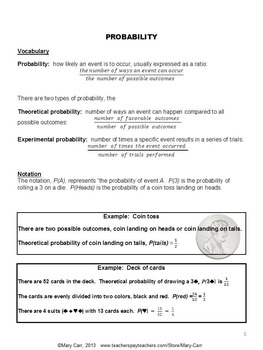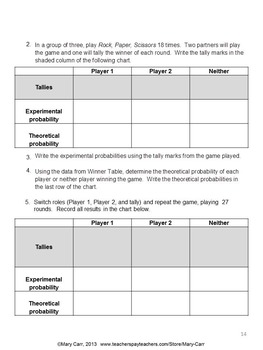Probability Station Activities
Mary Carr
872 Followers
Grade Levels
6th - 8th
Subjects
Resource Type
Standards
CCSS7.SP.C.6
CCSS7.SP.C.8
Formats Included
- PDF
Pages
31 pages
Mary Carr
872 Followers
Description
Three fun station activities for learning about theoretical and experimental probability and the Law of Large Numbers.
1) Spinning a spinner
2) Playing "Rock, Paper, Scissors"
3) Rolling a pair of dice
This resource includes:
- a printable overview of probability vocabulary and notation
- pre- and post-activity questions
- data collection sheets
- a summative quiz
- ALL answer keys
Each activity is designed for small groups (ideally 3 students) who will first determine the theoretical probability of events. They conduct the experimental task three times, increasing the number of trials each time. Results lead to the recognition that theoretical probability is better approximated with greater numbers of trials - the Law of Large Numbers.
Students will think they're playing while they're learning and demonstrating experimental and theoretical probability.
Please see the preview to see more of the pages of this resource.
Your students might also enjoy these activity-based products:
Divisibility Rules activities
Ratios, Fractions, Decimals, Percents
Please note that purchase of this product gives license for use to the purchaser alone. Additional licenses are available. Thank you for respecting the copyright of the author.
1) Spinning a spinner
2) Playing "Rock, Paper, Scissors"
3) Rolling a pair of dice
This resource includes:
- a printable overview of probability vocabulary and notation
- pre- and post-activity questions
- data collection sheets
- a summative quiz
- ALL answer keys
Each activity is designed for small groups (ideally 3 students) who will first determine the theoretical probability of events. They conduct the experimental task three times, increasing the number of trials each time. Results lead to the recognition that theoretical probability is better approximated with greater numbers of trials - the Law of Large Numbers.
Students will think they're playing while they're learning and demonstrating experimental and theoretical probability.
Please see the preview to see more of the pages of this resource.
Your students might also enjoy these activity-based products:
Divisibility Rules activities
Ratios, Fractions, Decimals, Percents
Please note that purchase of this product gives license for use to the purchaser alone. Additional licenses are available. Thank you for respecting the copyright of the author.
Total Pages
31 pages
Answer Key
Included
Teaching Duration
3 days
Report this resource to TPT
Reported resources will be reviewed by our team. Report this resource to let us know if this resource violates TPT’s content guidelines.
Standards
to see state-specific standards (only available in the US).
CCSS7.SP.C.6
Approximate the probability of a chance event by collecting data on the chance process that produces it and observing its long-run relative frequency, and predict the approximate relative frequency given the probability. For example, when rolling a number cube 600 times, predict that a 3 or 6 would be rolled roughly 200 times, but probably not exactly 200 times.
CCSS7.SP.C.8
Find probabilities of compound events using organized lists, tables, tree diagrams, and simulation.





